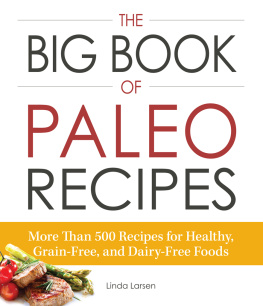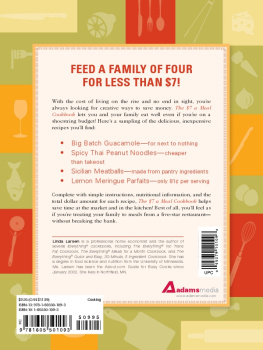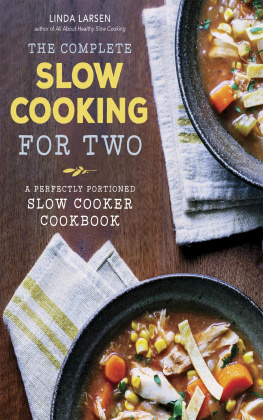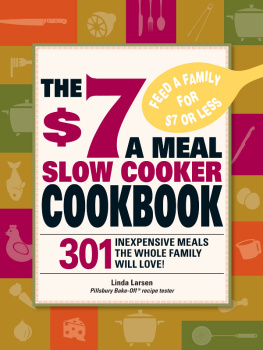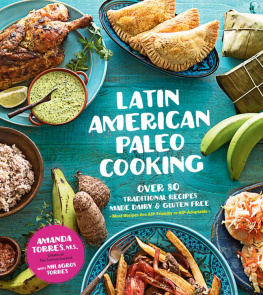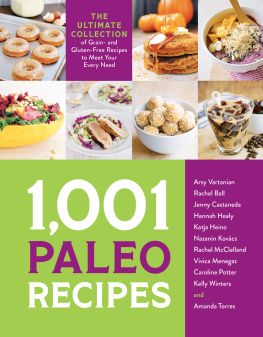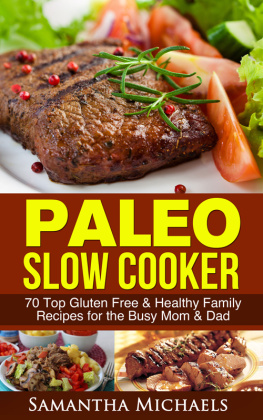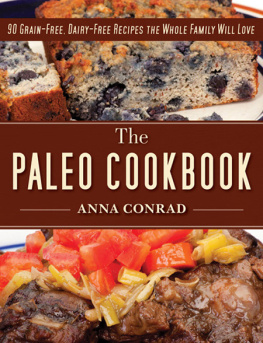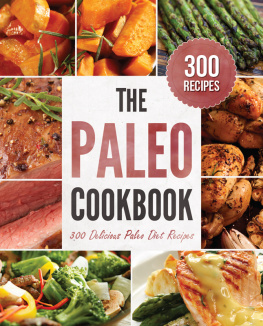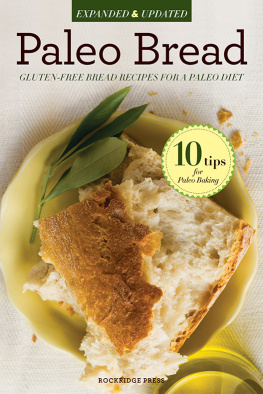Contents
Guide
The BIG BOOK of
PALEO
RECIPES
More Than 500 Recipes for Healthy, Grain-Free, and Dairy-Free Foods
Linda Larsen

Avon, Massachusetts
CONTENTS
INTRODUCTION
ARE YOU LOOKING FOR FLAVORFUL, NUTRITIOUS MEALS THAT WILL FUEL YOUR BODY? The Paleolithic diet is for you.
The Paleolithic diet or Paleo lifestyle has become increasingly popular in recent years. Also known as the Caveman Diet, the name refers to a period of time when people only ate grass-fed game, wild-caught fish, nuts, seeds, vegetables, berries, and occasionally other fruits. These people lived before the time of modern agriculture and the domestication of animals. They hunted for their meat and gathered their berries and nuts. There were no grains planted in fields, no milk past weaning, and, subsequently, the population wasnt plagued by many of the diseases that are seen today. Back then, there were no fast-food restaurants or packaged microwavable meals.
Ridding your body of toxins found in inflammatory foods such as grains and processed ingredients will contribute to increased energy levels. Your natural circadian rhythm, or body clock, will start working better, allowing you to pop out of bed after a great nights sleep. Your prescription medication and over-the-counter drugs may become a thing of the past. Aches and pains from arthritis or swelling joints may subside because you are consuming foods that do not irritate your body.
If this sounds too easy to be true, its not. If youre thinking that you need to move to the forest and take up hunting, fishing, and gardening to be on todays Paleolithic diet, that could not be further from the truth. The Paleo lifestyle simply requires a shift in your thinking. First, you will need to learn what foods are considered Paleo yes or Paleo no.
PALEO-FRIENDLY FOODS
Although the list of Paleo-acceptable foods is long, there are some choices that are more beneficial than others. Foods rich in omega-3 fatty acids promote optimal health and well-being. Some great omega-3 choices include:
Protein Sources of Omega-3
- Wild-caught salmon
- Cold-water fish such as mackerel, herring, and sturgeon
- Free-range poultry
- Grass-fed beef
Fat Sources of Omega-3
- Walnuts (particularly black walnuts)
- Brazil nuts
- Flaxseed
Carbohydrate Sources of Omega-3
- Broccoli
- Collard greens
- Raspberries
- Strawberries
On the Paleolithic plan, you will want to find fruits and vegetables with lower glycemic levels. These foods will not have a big impact on the blood sugar and insulin levels in your body. By keeping these levels lower and in balance you will promote wellness and reduce any unnecessary inflammation.
Foods with lower glycemic levels include:
Low-Glycemic Level Fruits
- Apple
- Apricot
- Cherries
- Grapefruit
- Kiwi
- Orange
- Lemon
- Pear
- Plum
- Strawberries
- Raspberries
Low-Glycemic Level Vegetables
- Asparagus
- Beet greens
- Broccoli
- Cabbage
- Carrots
- Cauliflower
- Celery
- Mushrooms
- Onions
- Red peppers
- Swiss chard
- Collard greens
FOODS TO AVOID ON THE PALEO DIET
Paleolithic hunter-gatherers ate foods that were pre-agricultural. They did not farm the land or herd animals for sustenance. Grains such as wheat, oats, barley, quinoa, and rice were not a part of their diet. Neither were potatoes or legumes of any sort, including soybeans and peanuts. When these foods are in their natural, raw state they are toxic for the human body because of the presence of toxins called lectins. Lectins have been linked to many ailments, but predominantly they cause leaky gut syndromes in human intestinal tracts. There are several symptoms of leaky gut syndrome. These symptoms include abdominal discomfort and pain, heartburn, bloating, gluten and food intolerance, and muscle cramps. In addition to lectin, diets high in processed foods, low in fiber and nutrients, and with high levels of additives contribute to this disorder. On the Paleolithic diet you would avoid all foods linked to this and many other diseases.
Some Paleo adherents avoid vegetables in the nightshade family which include tomatoes, eggplant, peppers, and paprika. Those foods were considered poisonous in the Paleolithic era, even though they are safe and nutritious. Nightshade vegetables do contain alkaloids, a natural pesticide, along with saponins and lectins that can contribute to leaky gut. If you have problems with inflammation, you may want to avoid these foods.
The use of salt in the Paleo diet is controversial. Some who interpret the diet strictly do not add salt to their foods. Others think that salt has been used for centuries and can be used in foods eaten on this diet. It is true that most Americans eat too much salt, but most of that is found in processed foods. Since processed foods are not allowed on the Paleo diet, adding small amounts of salt to recipes is not problematic. If you do choose to use salt, look for salt that is minimally processed with no additives.
Dairy Products
The plight of animals in the dairy and factory farm industry is alarming. As farmers inject livestock with hormones to boost productivity and feed them antibiotics to mitigate disease that can thrive in crowded conditions, consumers are slowly ingesting these compounds themselves. And antibiotic-resistant bacteria are becoming more common, making foodborne illnesses more serious and difficult to treat because of factory farming practices. Always look for grass-fed and organic beef and bison products and free-range chicken and poultry products to avoid hormones and antibiotics.
Many people on the Paleo diet do not consume any dairy products. Some people on the Paleo diet do eat dairy products such as heavy cream, butter, and cheese. Others do not eat dairy because they are lactose-intolerant or just feel better on a dairy-free diet. Some of the latest nutritional research shows that those who eat high-fat dairy products have a lower risk of developing diabetes. Dairy can add nutrition and interest to many foods, if used in moderation.
If you do choose to eat dairy, make sure you only buy organic cream, butter, yogurt, sour cream, and cheese made from grass-fed, free range cows. Avoid products made with added coloring such as Yellow No. 5 and annatto. Raw dairy can be risky, since unpasteurized milk and cream and raw milk cheese can contain pathogenic bacteria that can make you very sick.
You can add dairy or leave it out in all of these recipes. Substitutions are offered for a dairy ingredient if you choose to avoid those products. Use coconut cream in place of heavy cream, olive, avocado, or coconut oil in place of butter; almond or coconut yogurt instead of dairy yogurt; and vegan cheese for regular cheese.
At any rate, consider adding calcium-fortified foods and supplements to your diet as well as eating the following vegetables that contain calcium.
Calcium-Rich Foods
- Bok choy
- Dandelion greens
- Collard greens
- Sweet potato
- Swiss chard

